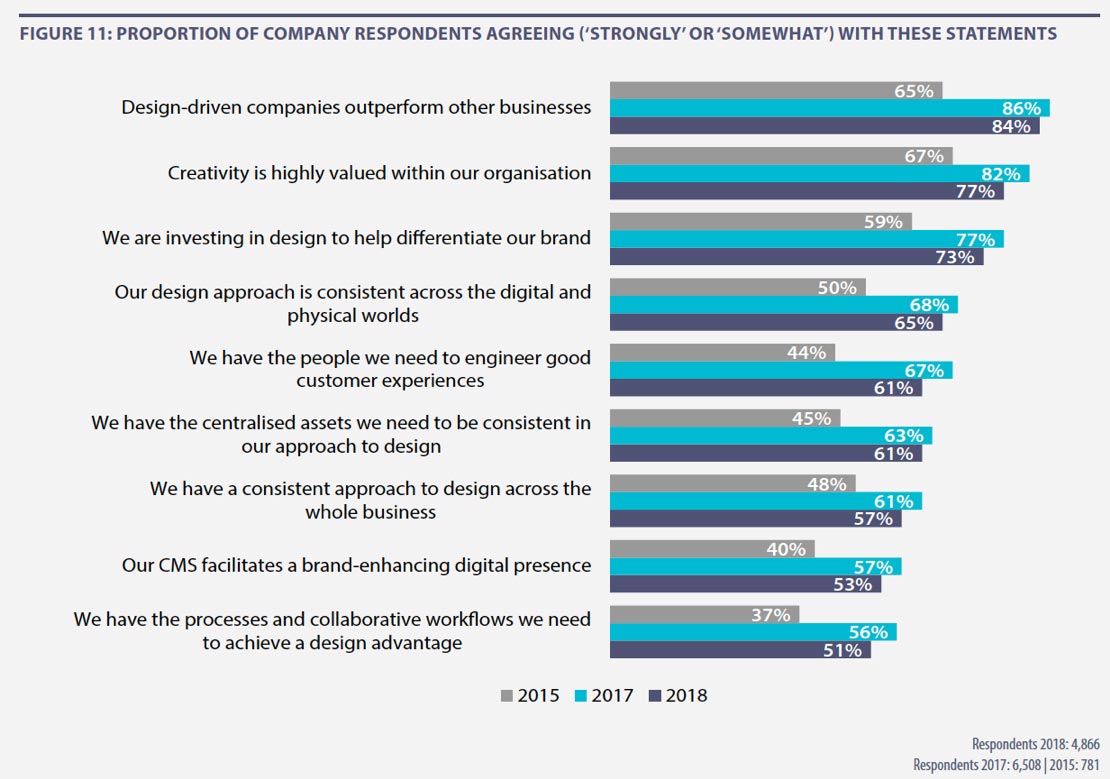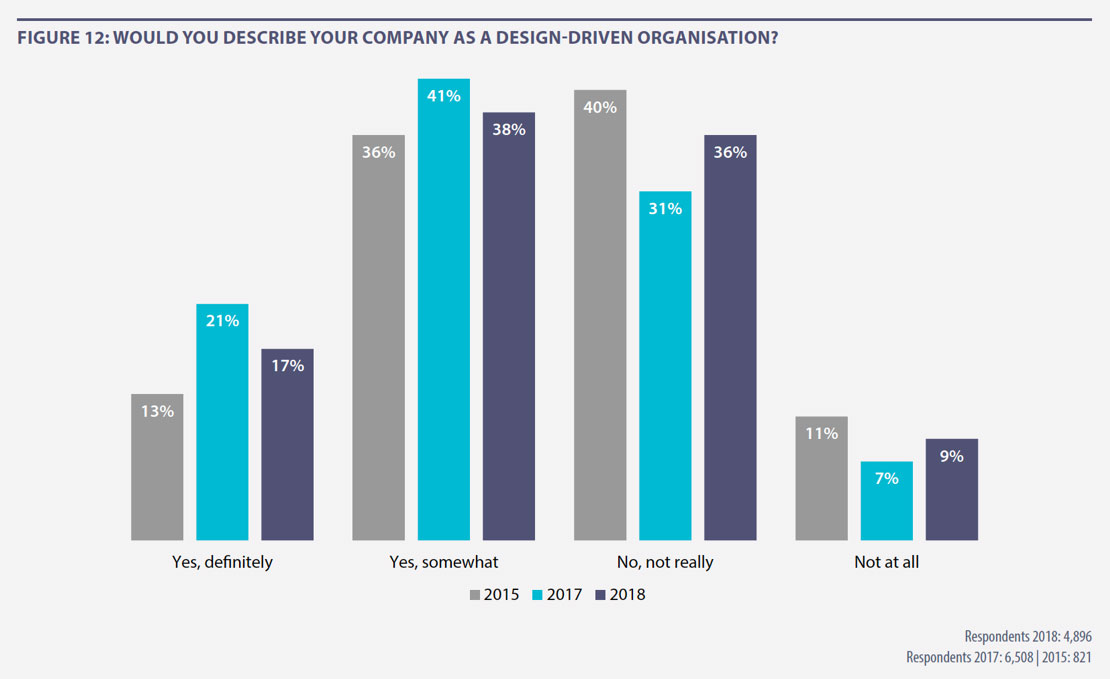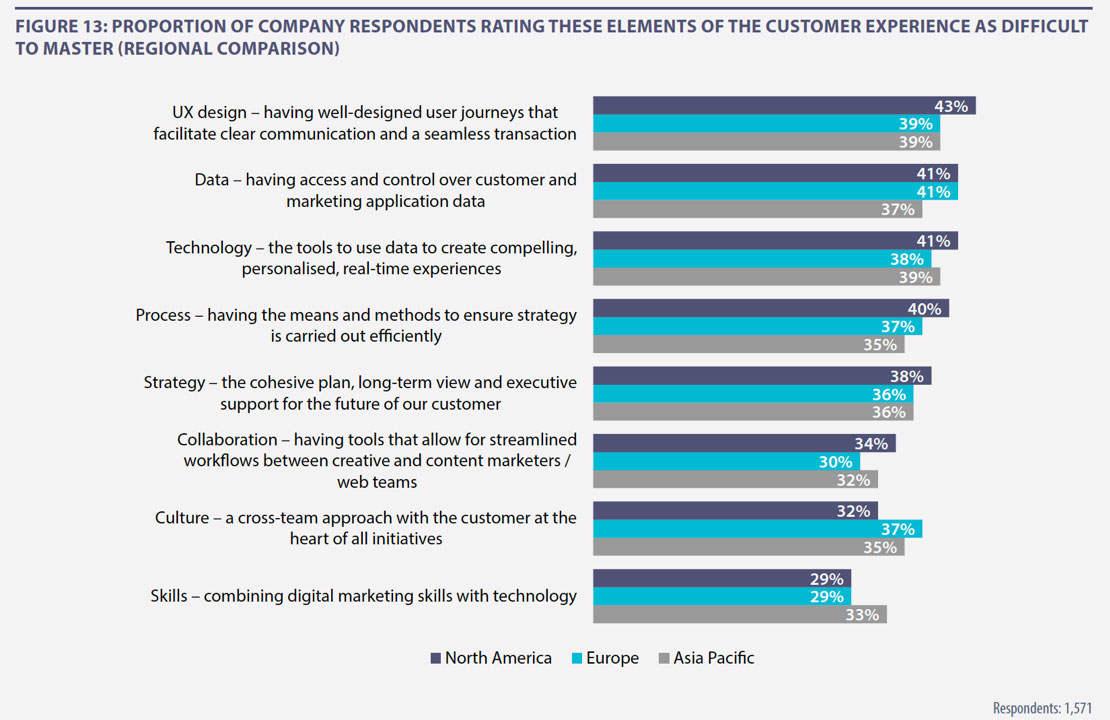The design and creativity renaissance
Making the complicated seem simple doesn’t happen by luck. It takes excellence in experience design (including product and service design), a capability which has never been more important for businesses that want to succeed in establishing and maintaining customers’ loyalty. When respondents were asked whether they believed that design-driven companies outperform other businesses, the overwhelming majority (84%) indicated they continue to agree this is the case (Figure 11).

The survey has found that just under three-quarters (73%) of respondents say their companies are investing in design to differentiate their brands (Figure 11). According to the Design Management Institute’s Design Value Index8, design-driven companies outperformed the S&P 500 by 219% between 2005 and 2015. Our analysis of data for this report provides more evidence that a design-first approach pays dividends, with these companies 69% more likely than their peers to have surpassed their business goals last year by a significant margin (22% vs. 13%).
Despite this compelling evidence about the value of design, there has been a decline in the proportion of companies that describe themselves as design-led. As can be seen in Figure 12, only 17% of respondents describe themselves ‘definitely’ as such, a decrease from 21% in 2017 though still higher than in 2015. Companies in the Asia Pacific region are most likely to say they are ‘definitely’ design-led (22%).
The overall fall in the number of respondents claiming that their companies are design-driven is difficult to explain, though it appears that larger organisations are struggling the most to embed this ethos within their businesses. Only 12% of the largest companies (those with annual revenues of more than £150m) say they are definitely design-driven.
Despite the fall in design-driven companies, there remains an appreciation that creativity, along with design, are key components for effective marketing and creation of great customer experiences. Figure 11 also shows that more than three-quarters (77%) of respondents believe creativity to be ‘highly valued’ within their organisation, a drop from 82% in 2017, but still ten percentage points higher than 2015.
Although agencies and user experience experts can play a key role in helping companies to remove the friction from the customer experience, organisations will benefit from having the in-house skills to oversee this. Disappointingly, the proportion of companies who say they have the people they need to engineer good customer experiences has fallen from 67% last year to 61% (Figure 11), suggesting that companies face a significant challenge in finding the right talent.

This challenge is exacerbated by the inherent difficulty in mastering UX design. In fact, a strong UX capability (described as the ability to create well-designed user journeys that facilitate clear communication and a seamless transaction) is regarded as the most difficult to master, harder than a host of other fundamental areas such as data, technology, strategy, culture and skills (Figure 13).
Design-led thinking is ultimately about having the customer at the heart of your business strategy, building the experience based on an intimate understanding of how people use your products and services, and where there is friction in the process to iron out.
While individuals who specialise in UX and service design are important, an organisational approach to design means ensuring that individuals from different customer-facing departments are building as clear a picture of use cases as possible, and contributing to design-driven solutions. Companies are also more likely to learn from their failures than their successes, so it is important that organisations use setbacks as a springboard for CX improvements.
There is a mixed picture when it comes to the extent to which companies have a consistent approach to design across the whole business, with only 57% of respondents agreeing that this is the case (Figure 11). Similarly, less than two-thirds (65%) of organisations agree that design is consistent across the digital and physical worlds.
Speaking at Adobe MAX—The Creativity Conference last year, Adobe CEO Shantanu Narayen said that we are living through ‘the dawn of the 21st Century Renaissance’. According to Narayen, the first Renaissance period famed for the likes of Michelangelo and Leonardo da Vinci focused on the individual artist, but the blend of art, science, data and design that defines the new renaissance will take human creativity to new heights.
Adidas is a good example of a brand that has worked hard to embed digital thinking into its design processes, including core principles such as testing, iteration, understanding the user and solving pain points. Simone Cesano, Senior Director of Design Operations at Adidas, told the same conference that one of the secrets to their success in digitising the design experience was harnessing the talents of the company’s early adopters: “The first thing we realised is that there is always a small number of individuals in any company that are early adopters. These are people within the organisation who will try new things just because they are new.” 9
